I am trying to model a 1-D advection-diffusion problem involving a variable advection velocity. It concerns a block of ice flowing downwards. I experience problems with an unphysical discontinuity occurring at the point in the grid where the velocity changes (plot attached). The code works fine for the case of constant velocity. Any help will be very much appreciated
Top plot the advection coeff as a function of depth
Middle plot: the temperature profile of the cie slab as a function of depth. The boundary conditions are 273 and 223 for the two edges and the discontinuity appears at the point where the advection coefficient changes
Bottom plot: The same problem solved for a constant advection velocity equal to -0.05 m/y = green dashed curve is the initial condition, blues curves show the evolution of the profile at various time steps and the red curve is the final solution for t = 1e5 years.



import numpy as np
from scipy import interpolate, signal, ndimage, integrate
import openpyxl
import matplotlib.pyplot as plt
import matplotlib.ticker as ticker
from matplotlib.ticker import MultipleLocator, FormatStrFormatter, FixedLocator, FixedFormatter
from matplotlib.backends.backend_pdf import PdfPages
import time
import pprint
import fipy
plt.rc("legend", fontsize = 16)
plt.rcParams['text.usetex'] = True
plt.rcParams['font.family'] = 'sans-serif'
plt.rcParams['font.sans-serif'] = ['Arial']
plt.rcParams['axes.labelsize'] = 16
plt.rcParams['axes.titlesize'] = 16
plt.rcParams['xtick.labelsize'] = 16
plt.rcParams['xtick.direction'] = "in"
plt.rcParams['ytick.labelsize'] = 16
plt.rcParams['ytick.direction'] = "in"
plt.rc('text.latex', preamble=r'\usepackage{cmbright}')
plt.rcParams["figure.autolayout"] = False
plt.ion()
plt.close("all")
H = 2764
dx = 10
dt = 100
t_total = 20000
plotit = True
llib_dict = {"H_llib": 2579, "a_llib": 0.016, "p_llib": 5.5}
lliboutry = False
sim_dict= {"H": H, "dx": dx, "dt": dt, "t_total": t_total, "llib_dict": llib_dict}
t1 = time.time()
if plotit:
plt.close("all")
f1, axes1 = plt.subplots(nrows = 1, ncols = 1, num = 5522, figsize = (6,6), tight_layout = True)
axes1.set_ylabel(r'Temperature [K]')
axes1.set_xlabel(r'z from bedrock(m)')
f2, axes2 = plt.subplots(nrows = 1, ncols = 1, num = 5523, figsize = (6,6), tight_layout = True)
axes2.set_ylabel(r'Advection [ma-1]')
axes2.set_xlabel(r'z from bedrock (m)')
nx = H/dx
sim_dict["nx"] = nx
mesh = fipy.Grid1D(dx=dx, nx=nx)
sim_dict["mesh"] = mesh
X = mesh.faceCenters[0]
Xc = mesh.cellCenters[0]
one_yr = 365.25*24*3600
t_total_s = t_total*one_yr
sim_dict["t_total_s"] = t_total_s
dt_s = dt*one_yr
sim_dict["dt_s"] = dt_s
n_steps = t_total_s/dt_s
sim_dict["n_steps"] = n_steps
D_ice = 1.13e-6 #m2s-1
sim_dict["D_ice"] = D_ice
k_ice = 2.1 #Jm-1K-1s-1
if lliboutry == True:
p = llib_dict["p_llib"]
d = np.arange(0, llib_dict["H_llib"] + 1, 1)
lamda_lliboutry = llib_dict["a_llib"]*(1-(p+2)/(p+1)*d/llib_dict["H_llib"] + 1/(p+1)*(d/llib_dict["H_llib"])**(p+2))
conv_coeff_arr = fipy.FaceVariable(mesh = mesh, name = "conv_coeff", value = [-np.interp(mesh.faceCenters.numericValue[0], d, lamda_lliboutry, right = 1e-7)[::-1]])
else:
conv_coeff_arr = np.zeros_like(mesh) - 0.05 #convection coeff
conv_coeff = fipy.FaceVariable(mesh = mesh, value = [conv_coeff_arr/one_yr])
conv_coeff.setValue(-1e-1/one_yr, where = (X<=H/2))
sim_dict["conv_coeff"] = conv_coeff
F = (D_ice*dt)/(dx**2)
sim_dict["F"] = F
sim_dict["Pf"] = D_ice/np.mean(conv_coeff)
print("\n")
print("Dice: %0.3e" %D_ice)
print("conv_coeff_mean: %0.3e" %np.mean(conv_coeff))
print(("F number: %0.3e" %F))
temp_left = 270.15
temp_right = 223.15
flux_left = 0
phi = fipy.CellVariable(mesh = mesh, name = "Temperature", value = 218.15)
phi.setValue(250.15)
eqX = fipy.TransientTerm() == fipy.DiffusionTerm(coeff=D_ice) -fipy.PowerLawConvectionTerm(coeff = conv_coeff)
phi.constrain(temp_left, where=mesh.facesLeft)
phi.constrain(temp_right, where=mesh.facesRight)
if plotit:
axes1.plot(Xc.value, phi.value, linewidth = 0.9, color = "g", linestyle = ":")
for i in np.arange(n_steps+1):
eqX.solve(var = phi, dt = dt_s, solver = fipy.LinearLUSolver(tolerance = 1.e-15))
print("\t%i/%i steps - %i y" %(i, n_steps, i*dt_s/one_yr), end = "\r")
if i%(n_steps/4)==0:
if plotit:
axes1.plot(Xc.value, phi.value, linewidth = 0.7, color = "b")
if plotit:
axes1.plot(Xc.value, phi.value, linewidth = 0.7, color = "r")
axes2.plot(X.value, conv_coeff[0].value*one_yr, linewidth = 0.8, color = "k")
print("\n")
exec_time = time.time() - t1
sim_dict["exec_time"] = exec_time
sim_dict["phi"] = phi
pprint.pprint(sim_dict)


